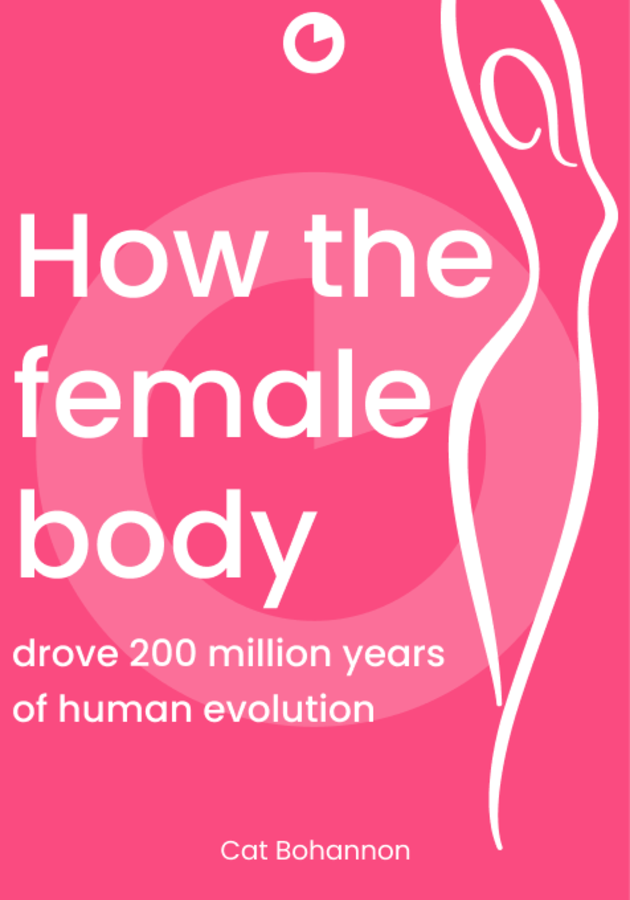How has the female body influenced 200 million years of human evolution? Why is the female lifespan longer than the male? Why are women more prone to Alzheimer's? Why do girls outperform boys in academics until puberty, after which their scores decline? Is sexism a driving force in evolution? And what's the deal with women experiencing night sweats during menopause?
These questions are sparking fascinating scientific exploration. Cat Bohannon explores the last 200 million years, employing boundless curiosity and sharp wit to elucidate the scientific underpinnings of female development. She advocates for a comprehensive understanding of the female mammalian body—a user's manual.
This involves a no-nonsense, thoroughly studied, yet intuitive description of female evolution and biology. By placing the female body at the forefront, Bohannon argues, we not only enrich feminism but also enhance disciplines like modern medicine, neurobiology, paleoanthropology, and evolutionary biology. It's time to discuss breasts, blood, fat, vaginas, and wombs—how they evolved and how we use them today, regardless of how peculiar or amusing the truth may be.
Prehistoric survival and evolutionary origins of breastfeeding
We travel back to prehistoric times to meet Morgy, a small prehistoric mammal, and her nightly struggles to survive in a world full of dangers. She hunts for food and returns to her burrow to care for her young. Through an illustrative presentation, the author introduces us to the evolutionary origins of breasts and breastfeeding in mammals, emphasizing their vital role in nurturing offspring and ensuring their survival in a harsh environment. Bohannon here highlights the challenges newborn animals face and how mothers, like Morgy, have evolved strategies to protect their offspring. It explains the importance of water for newborns and how breast milk serves as their first source of hydration. In addition, it discusses how breast milk helps fight disease and supports the development of the infant's immune system.
Through deeply researched facts, she details how mammalian milk production evolved to provide hydration, essential nutrients, and immune support for newborns. She then shifts her focus to the composition of breast milk by investigating prebiotic components such as oligosaccharides. Discusses how these sugars support the growth of beneficial bacteria in the infant's gut, contributing to the digestive and immune systems.
Furthermore, the author explores the emerging industry of processed breast milk products aimed at providing these benefits to premature infants. She shares the complex scientific concepts surrounding breastfeeding and mammalian evolution, highlighting the crucial role that breast milk has played in ensuring the survival and well-being of offspring throughout history. She discusses various aspects of milk, breastfeeding, and the relationship between humans and their gut bacteria.
Nowadays, Biotech companies are trying to create human-like sugars found in breast milk, but it's unclear if it's financially viable or if there's a market outside infant nutrition.
Scientists are exploring whether these sugars could be used in medical treatments for conditions like Crohn's disease and obesity, but more research is needed. Despite knowing the importance of gut bacteria for our health, there's still much to learn about how they interact with breast milk and our immune system. Milk's original purpose might have been solving water and immune system problems rather than feeding infants.
Breast milk composition is influenced by the environment and the mother's diet, and it contains a high diversity of oligosaccharides that may help with bacterial colonization and immunity. Our modern lifestyle and social behaviors have shaped the evolution of milk and its components.
Impact of maternal stress on breast milk composition
Bohannon initiates a discussion on the evolution of mammalian nipples and their role in breastfeeding with intriguing statements. She elucidates the mechanics of breastfeeding, encompassing the soothing reflex induced by sucking and the secretion of prolactin and oxytocin. Oxytocin serves various functions, including its involvement in emotional bonding and muscle contractions during labor and orgasm. Breastfeeding constitutes a multifaceted interaction between mother and baby, wherein the composition of breast milk adjusts to the baby's requirements, encompassing immune support and soothing effects. Bohannon explores various facets of breastfeeding, lactation, and the evolutionary significance of the human breast and nipple.
Today's acknowledgment is of particular significance that mothers' stress levels can influence the composition of breast milk, thereby impacting the behavior and development of infants. Elevated cortisol levels in milk may lead to babies exhibiting increased risk aversion and reduced sociability, while lower levels may encourage exploration and sociability.
Bohannon explains the evolutionary reasoning behind differences in milk content, arguing that milk adjusts to the environment to meet the baby's needs. For example, elevated cortisol levels in milk may help newborns save energy in risky circumstances. When analyzing the evolution of human anatomy, it is important to consider the evolution of male nipples. Bohannon observes that while men have nipples anatomically, their functionality is inefficient. She also recalls instances like the Aka tribe, where men could contribute and help with breastfeeding.
Furthermore, she explores how certain transgender women can induce lactation through hormone treatments, replicating certain aspects of pregnancy and breastfeeding. Recalling some diverse theories regarding the evolutionary development of the female breast, Bohannon concludes how these factors have influenced alterations in the mechanics of infant sucking, leg movement, and sexual selection. Breastfeeding customs, including the utilization of wet nurses, might have impacted population growth in ancient urban centers, potentially precipitating overpopulation issues.
Impact of cataclysmic events on mammalian reproduction
It's necessary to recognize the historical practices linked with breastfeeding, including the practice of hiring wet nurses across various societies and eras, and how these traditions have influenced population dynamics and societal structures. Following the cataclysmic event believed to have been caused by an asteroid impact, which resulted in widespread Earth destruction, the reproductive processes in mammals underwent abrupt changes. The extinction of dinosaurs marked the emergence of mammals, signifying the shift from egg-laying creatures to viviparity.
Here, the author delves into the evolution of the female reproductive system, highlighting the pivotal role of placental development and live birth in the success of mammalian species, including humans. Furthermore, the discussion addresses the complexities of female reproductive anatomy and the inherent risks associated with pregnancy and childbirth, shedding light on the evolutionary journey of mammals and the intricate interplay between environmental shifts, biological adaptations, and reproductive strategies.
By comparing the evolution of reproductive organs in mammals, focusing on disparities among marsupials, birds, reptiles, and humans, we discern the distinctiveness of each species. The story explains how marsupials' reproductive anatomy limits the size of their progeny and the difficulties they face during birth. It draws parallels between the reproductive systems of marsupials and placental mammals like humans, emphasizing the trade-offs and advantages inherent in each system. For instance, while marsupials possess multiple vaginas, placental mammals have a single one. However, this simplicity brings its own set of complications, such as the risk of urinary incontinence and prolapse in human females during labor due to bladder pressure and gravity.
Additionally, Bohannon explores the evolutionary significance of reproductive organs, including the coevolution of penises and vaginas in species, and how mate choice influences the development of these organs. Moreover, the discourse touches upon the repercussions of complex reproductive organs in species such as rhinoceroses, which encounter challenges in reproduction, contributing to their endangered status.
Exploring human sexuality and reproductive behavior
It was only a matter of time before artificial intelligence and technology became involved in biological processes, leading Bohannon to explore the intriguing realm of artificial wombs. She begins by discussing the groundbreaking creation of a mechanical womb, known as a "biobag," by American researchers in 2017. Although currently only applicable for part of the third trimester in lambs, this device promises to support newborns more akin to a natural pregnancy than what the NICU currently offers.
This exploration leads us into the evolutionary history of the uterus, tracing the transition from egg-laying to live birth and the challenges it posed for placental mammals like humans. Bohannon examines how lactating women had advantages in adapting to live births, having been accustomed to providing intensive care for their offspring after birth. The discussion further examines the quest to uncover the mammalian uterus's evolutionary origins, spanning between 150 and 200 million years. Bohannon discusses the evolution of the placenta, comparing it among different species, such as sharks. She addresses the challenges faced by paleontologists in pinpointing the exact origin of the mammalian uterus due to the scarcity of soft tissue fossils, mentioning "Donna," the hypothetical ancestor of modern placental mammals, believed to have lived around 66 million years ago. Donna's characteristics and evolutionary significance have influenced the adaptation of the uterus to support live births.
Additionally, Bohannon examines the relationship between body size, number of offspring, and uterine morphology, highlighting the evolutionary trade-offs involved in pregnancy and parturition. She investigates how developmental gaps offer insights into our evolutionary past and the selective pressures that shape uterine morphology. She also mentions the intriguing topic of human sexuality and reproductive behavior, examining theories about the evolutionary significance of menstruation. Challenging traditional views of menstruation solely as preparation for pregnancy, she explores alternative explanations, including social signals and collective behavior.
Furthermore, she discusses the cultural and social significance of menstruation throughout history, dispelling misconceptions and elucidating the biological functions of the endometrium. Bohannon emphasizes the importance of understanding the physiological processes of the uterus and its evolutionary adaptations beyond social constructs. She also points out the need to refocus scientific research on comprehending the biological functions of the uterus and its evolutionary significance.
Physiological differences and evolutionary influences
The author recalls her experience as a nude model at an art school during college, noting how male students initially depicted her body with exaggerated proportions, mainly focusing on her breasts, but gradually adjusted their drawings to reflect reality better. This prompts her to contemplate differences in perception between men and women, particularly in light of the male gaze and sensory reality. She observes that perception can easily be influenced by social norms and individual experiences, a phenomenon that has persisted since ancient times.
Transitioning to the evolutionary history of primates, the author examines the impact of environmental changes on their evolution, highlighting the role of plant life, including ferns and flowering plants, in shaping the emergence of early mammals and subsequent primates such as Purgatorius. This exploration highlights the interconnectedness of environmental shifts and biological development, with the plant world playing a pivotal role in the evolution of early primates, which were significantly influenced by environmental changes and physical adaptations.
Moving on to auditory adaptations, the author discusses how primates' ability to hear lower frequencies facilitated effective communication in densely forested environments, with the evolution of primate ears being influenced by the shift to arboreal habitats, enabling them to discern crucial sounds amidst the forest's cacophony. Here, she emphasizes the significance of auditory adaptation in primate evolution, promoting communication and survival in complex ecosystems.
Drawing parallels to human physiology, the author examines the physiological differences in hearing between men and women, mainly focusing on their varying perceptions of different pitch ranges. She explores how evolutionary factors, such as caregiving responsibilities, may have contributed to these differences in hearing, underscoring the intersection of biology and social dynamics.
Additionally, the author discusses the relationship between hearing and olfaction (sense of smell) and how these differences can impact behavior and social interactions. She investigates why women tend to retain their hearing better as they age compared to men, discussing the role of hair cells in the cochlea and differences in how men and women perceive and respond to loud environments. The author also touches on how sexual orientation may influence hearing sensitivity, comprehensively examining sensory perception and its implications on human biology and behavior.
Gender dynamics in early human history
Our olfactory system has gradually changed throughout human evolution, serving as a vital tool for detecting food, danger, and potential mates. The author observes human pheromones, mainly focusing on the influence of male scent on female attraction, noting variations based on sexual orientation and menstrual cycle. The significance lies in the profound impact of differences in hearing and smell between males and females on behavior and social interactions, including attraction and mate choice. This complexity enriches our understanding of human biology and behavior.
The author also explores early human history, specifically the evolution of tool use and the challenges our ancestors confronted, particularly concerning reproduction. Early used tools as weapons, symbolizing human dominance over nature. However, she challenges the conventional notion of male dominance in tool invention, suggesting that women may have pioneered early tools for practical purposes like hunting and survival. While tool use was pivotal for survival rather than merely symbolic, it's noteworthy that this skill isn't unique to humans, as evidenced by tool usage among intelligent animals such as octopuses and crows.
Gynecology, the medical discipline concerning female reproductive health, is argued to have been instrumental in the survival and success of the human species. Bohannon discusses the perils and complexities of human reproduction, highlighting the risks early females encounter during pregnancy and childbirth. The evolution of midwifery among humans and other primates is explored, proposing that assisting in childbirth may have fostered cooperative societies. Observations of monkeys and bonobos aiding at births are contrasted with chimpanzee behavior, suggesting that early human ancestors likely embraced a bonobo-like cooperative female social structure, fostering the emergence of midwifery and other reproductive choices.
The overarching message points out the undeniable role of cooperation and trust between women in shaping obstetric and reproductive practices. Finally, the chapter accentuates the significance of social structures and behaviors in molding evolutionary processes.
Final notes
In "Eve," Cat Bohannon guides readers through the evolutionary journey that shaped modern humans, focusing on the female body. The book offers a captivating exploration, blending thorough scientific research with accessible language for non-scientists. Bohannon, who was pursuing her Ph.D. while writing, brings a wealth of expertise and a background in creative nonfiction, narrative, and cognition. The title "Eve" represents multiple pivotal females throughout evolutionary history, from the early mammal Morgie to modern Homo sapiens.
One particularly intriguing chapter explores the role of tools in human evolution, challenging the male-centric depiction often portrayed in media. Bohannon argues that gynecology, encompassing various forms of birth control and fertility interventions, played a crucial role in human reproductive success, fundamentally shaping our species' trajectory.
It isn't just a sweeping reassessment of human history; it's a critical correction for a world disproportionately centered on the male body. It builds upon the foundation laid by "Sapiens" and promises to reshape our understanding of evolution and the success of Homo sapiens as a species.
"Eve" prompts readers to reconsider their perceptions of human evolution and the female body's significance in society. It's a must-read for anyone seeking a deeper understanding of our origins, filled with humor and relatable anecdotes.
12min tip
If you enjoy memoirs exploring the complexities of family, culture, and identity, then "Crying in H Mart" by Michelle Zauner is a book you won't want to miss. From her experiences as a Korean American growing up in Oregon to navigating adulthood on the East Coast, Zauner's storytelling is heartfelt and captivating.





























